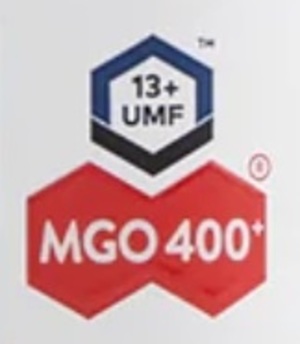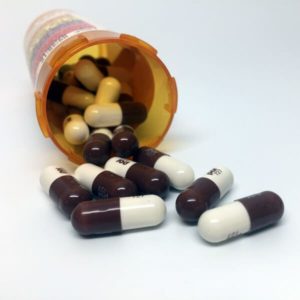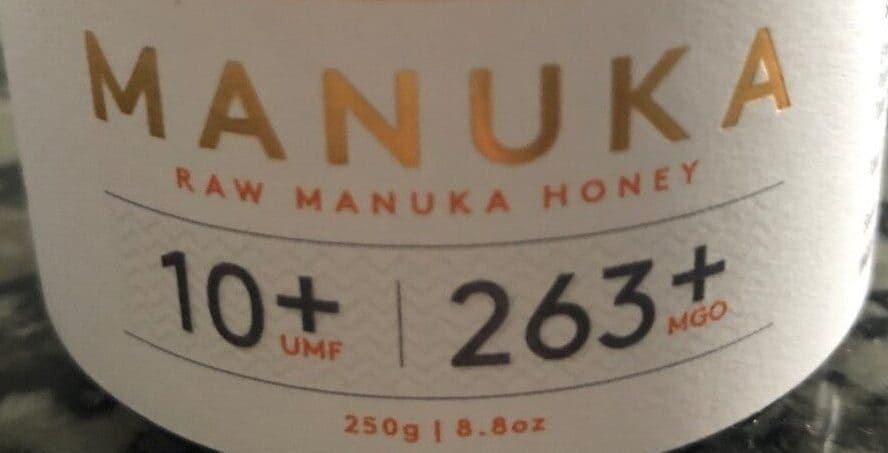
Is Manuka Honey Worth The Price?
A look at Manuka honey’s value as a health food
In recent years honey has seen an upswing in popularity as a healthy alternative to processed sugars. No honey has exemplified the insatiable demand for honey as a health food more dramatically than manuka honey. Exports (measured by dollars) of manuka honey from New Zealand quintupled from 2010 to 2020. Manuka honey can be found in almost any shop that carries healthy foods, at prices up to, and even exceeding $50 for a small 250g jar, several times the price of “regular” honey. At these prices, it begs the question, is manuka honey worth it?
What is manuka honey?
Manuka honey is the honey produced when honeybees forage nectar from Leptospermum scoparium a flowering tree native to New Zealand and Australia also known as the manuka tree. Manuka honey is dark in colour and strong in flavour. While opinions on manuka honey’s unique flavour range from exquisite to disgusting, most agree that manuka honey is less sweet than most honey but exhibits a complex array of flavours. Like other dark honeys, manuka honey likely has relatively high concentrations of a class of organic compounds called flavonoids. These flavonoids not only contribute to the colour and flavour of the honey, but are thought to contribute to health benefits when consumed.
Health benefits of honey never tasted this good
What manuka marketers don’t tell you is that the benefits they advertise for manuka are simply the benefits of eating any raw honey. If you’re eating the honey, our honey, like any pure raw honey, has similar health benefits as manuka honey. Get 20% off the next time you buy healthy, pure, raw honey from us online with coupon code TastyHealth.
What is special about manuka honey?
For millennia honey has been known to promote wound healing when applied directly to the wound. Modern research has verified this and elucidated some properties of raw honey that confer its wound-healing ability1. In the 1980s Professor Peter Molan discovered that honey from the manuka tree contained a distinct antibacterial compound that was different from compounds that confer antibiotic activity to most other honeys. In 2007 this compound was identified as methylglyoxal, commonly abbreviated as MGO. Raw honey has enzymes that catalyze the production of hydrogen peroxide, and it is these enzymes which give normal honey much of its anti-bacterial potency. Unlike enzymes found in other honeys, which break down when heated, causing honey to lose its anti-bacterial properties when pasteurized or sterilized by heat, MGO remains intact even at high temperatures. Since the discovery of methylglyoxal’s ability to withstand sterilization by heating and still kill bacteria, much research has followed quantifying manuka honey’s ability to eradicate virtually any bacterium ever to grace a petri dish, including the multi-drug resistant “superbugs” that are the scourge of any hospital. You might be surprised to learn that this is a property shared by ANY natural raw honey2. What sets manuka honey apart from most (but not all) other honeys is that manuka honey is retains strong anti-bacterial properties even after being heated to the point of sterilization.
Why does this matter?
My grandmother was a nurse. She reported that in her earlier days, raw honey was commonly used as a treatment for wound infections. However, over time health-care attitudes and policies changed, and unsterilized raw honey was no longer considered safe enough for wound dressings in North American hospitals. These days, only sterilized wound dressings are normally acceptable in a modern health-care environment, greatly decreasing the use of raw honey in wound dressings3. Manuka honey captured the health-care world’s attention with the discovery it was exceptionally well-suited for making sterilized, medical-grade wound dressings. By its use as a potent antibiotic in wound dressings and wound infections, active against even strongly resistant bacteria, manuka honey provided a natural, cost-effective solution to the growing problem of antibiotic resistance in hospitals.
What do sterilized wound dressings have to do with healthy eating?

Aside from marketing publicity, not much. A quick glance at the manuka honey in the food section of the store will reveal that price is closely related to its MGO or UMF numbers. MGO is a measure of the concentration of methylglyoxal. The term “Unique Manuka Factor” (UMF) appears to me to be an obvious marketing tactic: a way of “rebranding” the methylglyoxal concentration into a marketable metric of health benefits exclusive to manuka honey. UMF is essentially reflective of MGO concentration4, and therefore primarily reflects the suitability of manuka honey for making sterilized wound dressings. I should be perfectly clear that I do not mean to disparage manuka honey in any way. Manuka honey is clearly both an exceptional honey given its suitability for making medical grade wound dressings. If the manuka honey is both real honey (which, according to this article, is often not the case5) and raw, it’s as healthy to eat as any other raw honey. I do take issue with marketers that, by their efforts to promote their product, may be misleading consumers into believing that the healthiness of honey as a food is a product of its methylglyoxal concentration with a greater MGO or UMF number equating to greater health benefits6.
While anti-bacterial properties are paramount when making wound dressings, their relevance to healthiness in foods is much less. Unless you require treatment for a specific bacterial infection, it is not healthy to consume antibiotics on a regular basis7. The real value of the antibacterial nature of honey you will use as a food is that honey doesn’t “rot” in a way that can harm you if eaten: raw honey is an extremely safe food to eat. If stored for long periods in sub-optimal conditions, raw honey can ferment. Unless it has fermented to the point of becoming mead (and you chug copious quantities of said mead!) consuming fermented honey poses no health risk whatsoever. Contrast this with other unprocessed foods like meat, dairy, fruits and vegetables that can become toxic when they rot, or breads and other carbohydrates that readily grow mold, and the anti-bacterial (and anti-fungal) properties of raw honey can be appreciated for their true benefit of making honey an exceptionally safe food under wide-ranging storage conditions.
The health benefits of eating honey never tasted this good
The health benefits of eating honey

While raw honey’s antimicrobial properties make it and effective wound dressing, and prevent it from spoiling, they don’t account for the vast majority of honey’s value as a health food. Renewed interest in health benefits of natural foods in recent decades has prompted much research into health benefits of eating honey, with results that may surprise you. There is good research evidence from studies that eating raw honey:
- Improves sleep quality
- Soothes a sore throat and reduces cough
- Decreases the chance of developing diabetes8
- Is a healthy source of carbohydrates for exercise
- Decreases the chance of developing metabolic syndrome, which is a major risk factor for heart attacks
- Decreases the likelihood of developing stomach ulcers
- Decreases the risk of obesity and promotes weight loss if combined with exercise
Honey has long been known to exert anti-oxidant and anti-inflammatory effects. Newer research is also investigating these possible benefits of honey as a health food:
- Improved immune function
- Anti-cancer effects
- Treatment of stomach ulcers
- Decreasing blood pressure
- Anti-aging effects

The casual reader of manuka honey promotional material could be forgiven for assuming that these benefits of honey related to the MGO concentration or UMF number of manuka honey exclusively. Let me state with confidence that none of these benefits (and potential benefits) of honey as a healthy food relate directly to the MGO content/UMF rating: these are benefits you can expect from eating any natural honey. It is important to note that these are benefits specifically of raw, unprocessed honey. Heating and processing honey diminishes many, if not all, of these benefits – a subject I plan to explore in more detail in a later post. The bottom line is: Whether or not the honey is in its natural, raw state is a much more important factor than the MGO/UMF number in determining the overall “healthiness” of honey as a food9. Real, raw honey that you can get from your local beekeeper, your local farmer’s market or your local grocer will have these health benefits, while pasteurized, sterilized or adulterated honey (manuka or otherwise) will have greatly decreased health benefits (when consumed orally) regardless of the MGO/UMF number. To be perfectly clear, raw manuka honey does have all these health benefits, but the benefits do not correspond directly to the UMF or MGO rating. With manuka honey, as with any honey you intend to eat, ensuring your honey is real and raw is much more significant than comparing MGO numbers.
Don’t forget the main reason for eating honey
With modern marketing overly focussed on perceived health-properties foods (“gluten free”, “cholesterol free”, “reduced calories”, “non-dairy”, “low fat”, “A good source of XXXX”), it‘s easy to lose sight of the main reason people have loved honey since the first daring prehistoric honey hunters risked great physical pain, and possible death, from countless bee stings in order to enjoy this “nectar of the gods”: Honey is delicious. Real honey is not cheap: Eat honey that you enjoy.
A brief word from the sponsor of this post: Our honey’s not cheap, has zero MGO, tastes nothing like manuka honey, and we don’t recommend it for sterilized wound dressings. On the other hand, as one satisfied customer puts it “We have manuka honey that sits around forever but your honey was so delish that its almost gone!” Your health tonic isn’t healthing you sitting in the cupboard.
Get honey delivered fresh from our farm to your table.
Is manuka worth the premium price as a health food?
This is a decision each individual makes for themselves. Manuka honey has well-justified, strongly-evidenced, special value as a natural component of medical grade-wound dressings. Just like gold’s prettiness and status as a decorative metal make it a rather expensive for use in electronics, manuka honey’s value as a medical wound dressing has inflated its cost as a food. For me, personally, manuka honey’s price as a food is not justified from a consideration of its potential health benefits alone. You would almost certainly get comparable health benefits from eating any other raw honey, and there are plenty of more affordable authentic raw honeys out there. But it would be a sad world if food choices relied solely on an economical health-benefit analysis. Most of us have certain foods we love to indulge in. For me it’s cheese, sashimi, avocados, steak, coffee, red wine, strawberries, and a continuing long list. Sure, each of these foods can legitimately claim health benefits, but I can assure you that it’s not a measurable health benefit that prompts me to splurge on a bottle of 2007 Barolo wine, a wedge of 10-year-aged Gouda cheese, or a Wagyu steak. It’s the luxurious pleasure I get from savouring these rare treats. If manuka honey is one of your treats, then it’s probably worth the price to you. And, if you enjoy your manuka honey raw, unprocessed and unheated, you can feel good about the healthiness inherent in eating raw honey. On the other hand, if you’re looking for a daily oral health tonic, you could save your pennies by forgetting about MGO and buying another, more modestly priced, natural raw honey.
As always, we welcome any comments questions or opinions – post below or email us at info@wendellestate.ca.
Notes:
- Properties of raw honey that contribute to wound healing are its anti-microbial (antifungal and antibacterial), analgesic, anti-inflammatory, pro-inflammatory and anti-antioxidant properties, among others.
- This study compared the antibacterial properties of raw, non-manuka honey (“pasture honey”) directly with manuka honey on 58 common strains of bacteria involved in wound infections and found them to be similar: both manuka and non-manuka honey were effective against all strains of bacteria. Anti-bacterial properties of raw honey include its high osmolarity (low water concentration), acidity, and hydrogen peroxide, which is produced by heat-sensitive enzymes in the honey. Osmolarity and acidity can be diminished in environments (like wounds) where absorption of water is possible. Hydrogen peroxide is denatured by heating, which explains why the antibacterial properties of raw honey are much greater than that of processed, pasteurized or heat-sterilized honeys. (There is a method to sterilize honey for wound dressings that uses ionizing radiation rather than heat.). the heat-stable antibiotic properties of compounds in honey like methylglyoxal are often collectively referred to as “non-peroxide activity” or NPA. NPA is primarily relevant to honey used for sterilized wound dressing: It has decreased relevance for honey as a healthy food.
- The requirement for sterilizing raw honey is likely due to a concern of Clostridium botulinum wound infections as a result of raw honey treatment. Viable bacteria cannot grow in raw honey due to its strong antibiotic nature, meaning wound infection due to treatment of raw honey is extremely unlikely. However, inactive botulinum spores can exist in raw honey and could colonize a wound under exceptional conditions. (C. botulinum spores are the reason infants younger than one year of age should not eat honey. Read more about under “can infants eat honey” here.) It is possible to sterilize honey without applying heat by the use of ionizing radiation. Like the rest of the discussion pertaining to wound dressings and methylglyoxal, this is largely irrelevant to honey that you eat: it is only included to understand the background of manuka honey’s rapid rise.
- The “unique manuka factor” or UMF does claim to include measurements of leptosperin and dyhydroxyacetone to verify authenticity of the manuka source of the honey to combat rampant manuka honey fraud. UMF also is also claimed to measure non-peroxidase activity (NPA), but this would be closely related to MGO concentration: MGO gives manuka NPA. UMF may involve some qualitative assessment of honey “rawness” with an HMF measurement (more on raw honey and HMF in a following post). However, as this chart clearly demonstrates, UMF is essentially another, slicker-sounding way to express methylglyoxal concentration.
- The article does not describe in which way the manuka was “faked”. If it was some other honey, or manuka blended with some other natural honey, then the MGO/UMF numbers would be fraudulent marketing, but the actual healthiness of the honey may be similar that of genuine manuka honey. Instead, if the lower-tha-claimed MGO/UMF numbers indicate that the honey was adulterated with processed sugar syrups, then some of the benefits of honey would be replaced by the harms associated with consuming processed sugars.
- Long-winded rant on my personal beef with marketing and health: When I was a family medicine resident doctor, a relatively new antibiotic, levofloxacin (Levoquin) had been introduced. It was the first “respiratory flouroquinolone” (flouroquinolones are a class of antibiotics normally used for intestinal and urinary tract infections, but levofloxacin had high potency against bacteria that commonly cause pneumonia, a respiratory tract infection). Levofloxacin had rapidly became the “gold standard” for treating pneumonia among attending physicians at the hospital I worked in at the time. Then I attended a lecture by a prominent infectious disease specialist who asked, “What even is a ‘respiratory flouroquinolone’? It’s cleverly effective marketing by the pharmaceutical company! Prior to Levoquin’s intense marketing campaign, ‘respiratory flouroquinolone’ was a term nobody ever said.” He proceeded to present solid evidence on why the vast majority of pneumonias treated with levofloxacin at (often at taxpayer) cost of hundreds of dollars per course, could be equally effectively cured with older, possibly safer antibiotics at one tenth the cost. I feel that spending a lot of money to eat high-MGO honey as a daily health tonic is similar to spending hundreds of dollars on a fancy new antibiotic that has the same effect as the older, more affordable, less marketed ones. Rant over. Feel free to disagree in the comments or by email.
- Oral antibiotics have common and potentially serious side effects ranging from diarrhea and yeast infections to life threatening colitis, among others. Fortunately for us, despite honey’s natural antibiotic properties, eating raw honey does not have the same effect as taking prescription antibiotic tablets: the antibiotic properties of honey are effectively neutralized in the stomach. In fact, raw honey is thought to have pre-biotic effects, meaning that eating raw supports the healthy growth of healthy, beneficial bacteria in the intestines. The importance of having healthy bacteria growing in your intestines is receiving increasing attention and validation from research these days.
- Eating honey, especially if honey is substituted for processed sugar specifically decreases the chance of developing non-insulin dependent diabetes mellitus (NIDDM), or type 2 diabetes. The less common auto-immune disorder that results in insulin-dependent diabetes mellitus (IDDM) or type 1 diabetes is not affected by honey.
- In a roundabout way, it could be argued that MGO concentration decreases as manuka honey is adulterated. If you had two samples of honey with an MGO content of, say, 30, and one was sold “as is” while the other was diluted with sugar syrup until the MGO content was 15, then the pure honey of MGO content of 30 is certainly healthier than the fraudulent adulterated honey with an MGO content of 15. MGO content can represent a specific, pseudo-quantitative type of authenticity of manuka honey. However, I will stick to the assumption throughout this post that we are referring to pure, natural honeys and leave the pervasive issue of fraudulent, adulterated honey for separate discussions.
Share this story

3 comments
Hello, my name is Heidi and I’ve been researching and trying to find honey that the Canadian government has certified as real honey and not a jar of corn syrup.
Your honey looks delicious and I’ve read through the site information.
Amazon.ca is selling your honey and I’m wondering if it is yours because of all the fake jars and labelling scams lately that have scammed people. I look forward to hearing from you and ordering a batch for myself and family. I was wondering if the amazon.ca honey is authentic or if not, I will order directly from your website.
Hello Heidi
You are well informed on the issue of “fake honey”. As we produce, package and market Wendell Estate Honey we are truly a farm to table operation.
As for Amazon…we do know of one seller on Amazon who buys honey from us for resale on Amazon, however, we cannot guarantee the honey that is purchased from Amazon as the freshness of raw honey is dependent on it’s storage conditions.
I hope that answers your question and that you are soon able to enjoy some Wendell Estate Honey!
YES! I started Manuka honey when I was 66 years old and it got me through bronchitis and pneumonia that same year. I’ve had several chest x-rays and they are CLEAR!! I always buy MGO that is over 500.